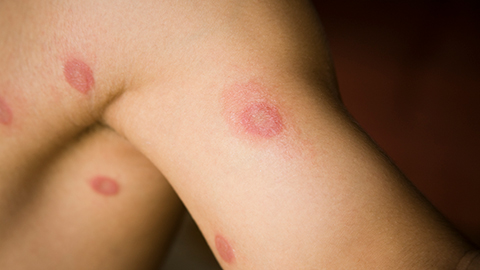
A client has an undiagnosed situation with the skin over their glute, and to the massage therapist it looks suspiciously like ringworm. What is ringworm? How do we get rid of it? And what is the risk to the massage therapist in this situation?
Listen to this episode of I Have a Client Who… as Ruth Werner talks about one of her favorite topics: ringworm (RW).
Resources: 
Pocket Pathology: /abmp-pocket-pathology-app
Mycoses Abounding (no date). Available at: /textonlymags/article.php?article=2068 (Accessed: 23 August 2023).


0:00:02.3 Ruth Werner: Hello I Have a Client Who listeners. Ruth Werner here, and I'm so excited to let you know that my library of online self-paced continuing education courses has just expanded. I now have a two-hour ethics course called A Doctor's Note is Not Good Enough and What Is Better? This NCBTMB approved course goes into why a doctor's permission or approval or even a prescription doesn't provide the legal or safety protection you might think it does. Then we look at how to start useful conversations with healthcare providers that will actually get us to safe and effective massage for our clients with complex conditions. Visit my website at ruthwerner.com for more information and to register for A Doctor's Note Is Not Good Enough and What Is Better?
0:01:00.1 RW: Hi, and welcome to I Have a Client Who, Pathology Conversations with Ruth Werner, the podcast where I will discuss your real life stories about clients with conditions that are perplexing or confusing. I'm Ruth Werner, author of A Massage Therapist's Guide to Pathology, and I have spent decades studying, writing about and teaching about where massage therapy intersects with diseases and conditions that might limit our client's health. We almost always have something good to offer, even with our most challenged clients, but we need to figure out a way to do that safely, effectively and within our scope of practice. And sometimes as we have all learned that is harder than it looks. Here's a fun one, dear listeners, that came in from a person who is my friend and my colleague, but I won't share any more specific information than that, and it goes like this. I have a client who, when I pulled back the sheet to drape their leg, they appeared to have ringworm on their glute, and then I said to myself, I wonder if that's what it could be.
0:02:09.4 RW: And in my after massage discussion, I said, I'm not a doctor and I can't diagnose, but you may want to google ringworm. I obviously need to be more specific with any new issues and check in with regular clients every time. Well, ringworm is one of my favorite topics because it's just really fun to unpack. Plus it has my initials. The terminology around this common skin condition looks hard, but when you apply just a tiny bit of Latin and Greek, it's easy to translate. Dermatophytosis is the group name for fungal infections of the skin, derma skin, phyto, which means plant and osis, which means pathological condition of. So pathologic condition of having plants grow on your skin. Easy, right? Is this making you itch yet. Another term that shows up in this context is mycosis, and you might already know that myco means fungus. A mycologist is a mushroom expert, so mycosis is pathologic condition involving fungi. And truthfully, the people who take all this very, very seriously argue quite correctly that fungi and plants are not really the same things, so it can be useful to delineate between them.
0:03:30.3 RW: The next set of terms describes where these infestations show up and the key word here is tinea, which means worm. When I was a child, my mother cautioned me against going barefoot outside because she said I might catch ringworm and somehow I envisioned that worms would invade the thick skin on the bottom of my feet and wriggle up into the rest of my body. And it was all sort of horrifying and I carried that picture in the back of my head until I got to massage school where I learned to my undying relief that there are in fact no worms in ringworm, not one, not even tiny ones. Tinea means worm because the lesions caused by the most common versions of fungal infections that aren't between the toes look like slightly raised flaky circles with lighter skin in the middle, sort of like circular worms that are burrowing under the skin, but in fact, what we're seeing is not the eruption of parasitic animals bursting forth, but the growth pattern of fungi, and we see this both on the skin and in nature.
0:04:49.3 RW: Have you ever heard of fairy circles? That's what happens. When a colony of mushrooms grows out from a central place and as they consume whatever nutrients are available in the soil, they drop their spores and spread out in a circle in their search for more food. And this is essentially what happens with tinea lesions on the skin. They start as a small, maybe slightly itchy spot, and as the fungi expand to new territory, the lesion grows into a circle-ish sort of shape that is more or less healed in the middle and most active on the outer edge, and this can go on for weeks or months or longer. I have seen some pictures of ringworm that look like they've been there for a really long time. So why, why, why doesn't our immune system recognize these invaders and just get rid of them? It's because they are similar enough to our own cells that we just don't recognize them as pathogens, or sometimes it's because the immune system might be overstretched to start with.
0:05:57.6 RW: I once interviewed a woman who got ringworm while she was in massage school from petting stray kittens. And she was working too hard and she was stressed out and she wasn't sleeping or eating very well, and her ringworm bloomed several days later and it took several weeks of treatment to get it to clear up. Now, at this point, I'm going to shift to read from an article I wrote for Massage and Bodywork on lots of different types of fungal infections. This came out in 2019 and it's a pretty efficient way to give you this key information. Then we can talk about our contributors story and their options. Ringworm is potentially contagious. People can catch it from other mammals, cats and dogs and horses are frequent carriers, or from each other, or they can spread it from one area of the body to another.
0:06:45.6 RW: It can also be spread through indirect contact. Hairbrushes, towels or shower room floors can help the fungi move from one host to another. That said, it is seldom a serious or threatening condition unless a person is immune-compromised in some way. Most healthy people can be exposed to these fungi and never develop lesions at all. There are several subtypes of cutaneous fungal infections, and because we work so closely with the skin, it's important for massage therapists and bodywork practitioners to be familiar with them.
0:07:18.2 RW: Tinea corporis or body ringworm is the development of the raised, slightly itchy scaly circles on the skin that widen as the fungi spread out in search of new nutrients. This can develop on the trunk or on the extremities. Tinea capitis or head ringworm involves infections of the scalp that can leave behind scar tissue and permanent patches of baldness. We mostly see this in pre-adolescent children. Tinea pedis or athlete's foot is a familiar one. This leads to itchy, weeping blisters with a risk of secondary bacterial infection between the toes. This is the most common type of fungal infection in the United States by the way. I'd love to do an episode about that. It seems I haven't yet, so by all means send me any I Have a Client Who stories about folks with athlete's foot please. There's a related type of athlete's foot that causes more typical ring shaped lesions on the rest of the foot. This is sometimes called the moccasin distribution and it looks just like dry skin, but it never gets better even with moisturizer. The fungi that cause athlete's foot thrive in warm, humid conditions like the insides of shoes, so it can be hard to get rid of this infection without changing footwear.
0:08:38.9 RW: Tinea pedis can also lead to new infections on the hands if a person isn't careful about washing their hands after handling their feet, and this is called tinea manuum. Tinea cruris or a jock itch is a fungal infection around the genitalia. It's usually seen in males because the female version of this is a vaginal yeast infection. It's important to note that the lesions associated with jock itch can be found on the genitals, but they can also be on the thighs, the buttocks, and over the sacrum, and of course, this has repercussions for bodywork. Onychomycosis refers to fungal infections of the finger and toenails. These lesions can be long-lasting and disfiguring, sometimes leading to the destruction of the whole nail. They're also resistant to many topical treatments. You might remember a set of TV ads from years ago for an oral medication to eradicate this toenail fungus, and it involved a character named Digger.
0:09:35.6 RW: Well, it turns out that that medication gave a lot of people pretty severe liver problems, so it's still available but no longer marketed so aggressively. More typical treatments for fungal infections include topical applications of antifungal medications. The woman with the kittens actually used tea tree oil and Vagisil, a treatment for vaginal yeast infections. I looked this up and it turns out that that's not a fabulous strategy. Typical over the counter Vagisil will help to minimize itching, but the main product doesn't have antifungal properties. I couldn't resist. I had to visit the Vagisil webpages and found that they do have some products that claim to be antifungal, specifically something called VAGISTAT. But you know what? This is not our call to make recommendations. So let's do the right thing and refer people to the appropriate medical professionals for their treatment of dermatophytosis. Okay? Right.
0:10:35.4 RW: Let's return to today's story. Everything in the massage is going well until the practitioner turns back the drape to uncover the leg and discovers something that looks like it could be ringworm on one buttock. You know what? This happens a lot. I had a friend eons ago who'd been working with a client's back and then they turned down the sheet 'cause it had kind of scooched up a little bit during their back massage, and that's when they discovered circular lesions all over this person's sacrum and glutes. The problem is their hands had already slipped under the sheet before they fixed it. They had definitely touched some of the lesions, and this is why I say over and over again that we must never, ever, ever touch something that we haven't seen. It sounds like today's contributor was safer on that score, but it's still a bit of a difficult situation.
0:11:34.8 RW: I mean, what would you do if you uncovered your client's leg or arm or belly and discovered an undiagnosed rash? And that, by the way, is the whole basis for one of my really popular CE classes called the Ethics of Client Communication, Talking to Clients About their Health, and I don't know what this practitioner did if they just skipped the area or what they decided about how to proceed. What we know for sure is that this came up in the post massage conversation. "I'm not a doctor, I can't diagnose, but you might want a google ringworm," is maybe a bit blunt depending on your relationship with your client. Some people might hear that as a judgment of some kind or they might freak out, "I have worms on my buttock!" In general, I usually recommend not getting quite so specific, but just to say that undiagnosed skin issues are a caution because we don't wanna make anything worse and we do wanna protect ourselves and our other clients, so please get this checked before you come in again or you know, words to that effect.
0:12:38.1 RW: From there you can decide based on lots of things like your relationship with the client and how far along you are in the massage and whether the skin looks super inflamed or itchy or weepy, whether you're gonna keep on working, what you might wanna do, skip the area maybe, or put on some gloves or maybe stop the massage altogether. I do wanna say that since we wash our hands so frequently, our risk of picking up ring room from our clients is relatively low, but it's another good reason to maintain our own good skin hygiene. I also wanna point out that not all ringworm looks alike. I've seen pictures of lots of different kinds and shapes and colors of ringworm lesions and there are a few other things that look really similar, but they're not contagious. Psoriasis, guttate eczema, the bulls-eye rashes seen with Lyme disease just to name a few. And aren't you glad that this isn't our decision to make?
0:13:33.7 RW: Our contributor finishes with a really great point, and I will leave with this. They said, "I obviously need to be more specific with any new issues and check in with regular clients every time." It's so easy to get complacent, especially with clients that we know well, and this allows us to miss what might be really important information like a change in their meds or a new injury or as in this case, something happening with their skin. I hope this short foray into the wonderful world of fungal infections hasn't made you too itchy, and I hope that you have a renewed sense of commitment to gathering all the relevant information you need, even from super familiar clients before you begin every session.
0:14:22.2 RW: Hey everybody, thanks for listening to I Have a Client Who, Pathology Conversations with Ruth Werner. Remember, you can send me your, I Have a Client Who stories to ihaveaclientwho@abmp.com. That's ihaveaclientwho, all one word, all lowercase @abmp.com. I can't wait to see what you send me and I'll see you next time.